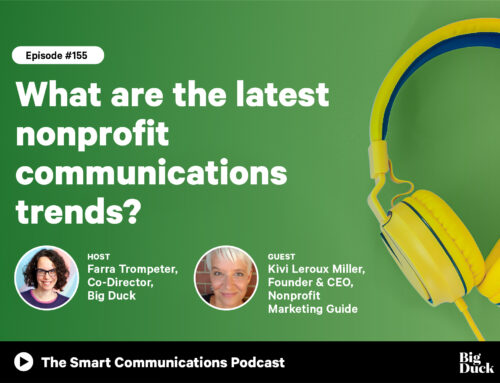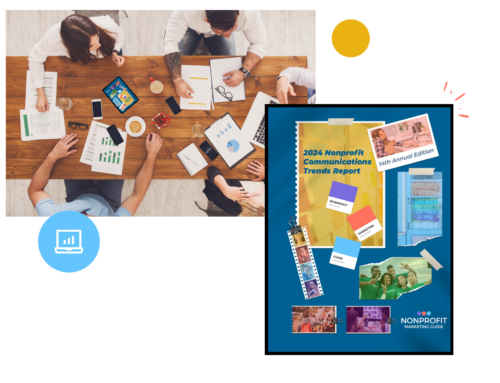Guest Post by Julia Reich of Julia Reich Design
Getting Started
To begin an infographic project, it’s important to determine at the outset what your overall goals are, and what message you want to convey. Find the story you want to tell with graphics, and mine your data to locate the facts that support that idea.
You will also need to provide some copy that accompanies the graphics which support this theme (for example, check out these infographics we developed recently for Kivi’s Nonprofit Communications Blog to accompany the 2012 Nonprofit Communication Trends report, and the headlines and text that go with each “chunk”).
Patrick Moroney is our senior designer at Julia Reich Design and has had a hand in designing several of our pieces. I discussed the process with him. “Good infographics relate to and support an overarching idea that’s trying to be expressed,” he offers, while “bad infographics are extraneous or eye candy.” His advice for nonprofits? “Be prepared to work collaboratively with us to determine the narrative you’re telling, and help us prioritize the data that best supports this.”
Creative director Kelly McManus, part of the internal marketing team at Open Arms of Minnesota (see Wednesday’s post), supports this idea. “Infographics are a team effort. We got started by creating an outline on what messages we wanted to convey and those certain things you have to report on as an NPO, and then there are things we bring in to warm it up in a way our audience would find inspiring. We worked together to create that list and then with different departments to obtain the statistics we needed. Finally, we sketched it out and started creating images.”
For her Palm Beach Opera infographic project (see Tuesday’s post), Ceci Dadisman provided the designers at Lemon.ly with final text she determined in advance the infographic needed to include, in three sections: 1) general opera statistics; 2) things you didn’t know about opera; and 3) about their 50th anniversary season. “We gave [our designers] free-er reign over the plot information section because they were not opera people and the audience are non-opera people. And they went from there. We gave them our brochure fonts as a guideline and PMS logo color. They gave us a wireframe proof first – how it would be laid out, and we approved it, and then there were a few rounds of revisions after that.”
Data Can’t Speak Unless You Ask it a Question
One of the most challenging aspects to creating infographics is getting good data to work with. Jeff Ferzoco at Regional Plan Association agrees: “Finding data is a challenge. All I know is it has to tell a story when you get it or it’s useless. I’ve been given a million pieces of data that go nowhere and it frustrates everyone.”
What do you need to know? Why do you need to know it? According to Kathy Nelson at K. Nelson Research, a consultant who specializes in using data to help nonprofits strengthen their services, the client’s answers guide the entire data collection and analysis processes, as well as the infographics that follow. “Data cannot speak for themselves”, Kathy says, “so without the framework that the client provides, the data will be mute.”
Once relevant data exists and their message is clear, the infographic process is a matter of visualization, refinement, and possibly even adding interactivity.
DIY Tools
If you’re seeking inspiration, check out visual.ly and visualizing.org, both sites that showcase infographics from all over (you can upload yours, too). And then there’s Good magazine, which is largely responsible for popularizing this visual data form yet continues to set the bar high.
I’ve never used them, but Google has a whole host of free tools you can use to 1) generate data (Google Insights), 2) clean up your messy data (Google Refine), and 3) visualize your data (Google Fusion Tables. Another option is tableau).
Going back a few steps, if you’re looking to collect data using a free online survey tool, try kwiksurveys.com.
There also a host of tips and resources in the free PDF manual Visualizing Information for Advocacy, which provide NGOs with “a useful and powerful tool for advocacy and research”.
Coming next: Promoting your piece in order to boost your site’s page rankings, how to measure its ROI, and the value of infographics as a marketing tool for nonprofits.
Julia Reich is principal of Julia Reich Design, which helps nonprofit organizations bring their mission to life with award-winning brand strategy, graphic design, and web design services. Clients love her team’s top-notch creative work combined with an affordable, personalized approach.







